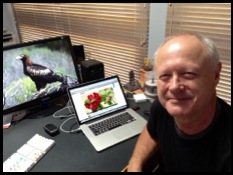Mar 2014
Deciphering Joseph Hooker's letters
18/03/14 10:35
I am currently trying to decipher a number of letters that Joseph Hooker wrote to Asa Gray, the great American botanist, between 1877-80. These were located at the Asa Gray Herbarium at Harvard last year where I was visiting to film correspondence between the two men following their trip across America in 1877. I was hoping to find letters where Joseph might have mentioned the similarities he noticed between the Flora of the Southern Rocky Mountains and that of the Russian Altai.
This has been of much interest to Bill Weber a veteran botanist in Colorado for many years. His paper is entitled ‘The Middle Asian element in the Southern Rocky Mountain Flora of the western United States : a critical biogeographical review’, William A Weber, Herbarium COLO, University of Colorado, Campus Box 265 Boulder CO 80309 USA, Copyright 2003 Blackwell Publishing Ltd. Bill had only seen passing reference to it and I was hoping to find out more as I was about to retrace Joseph’s and Asa’s travels through the American west. The idea seemed to get lost during the writing of an important paper by Joseph and Asa called ‘The Vegetation of the Rocky Mountain Region and a Comparison with that of other Parts of the World’ available as a reprint from www.rarebooksclub.com.
When I first contacted the Asa Gray Herbarium they thought they had only a few letters from Joseph during the years of interest but managed to find a number more for my visit. I photographed them and am now attempting to decipher them. As anyone who has tried to read Joseph’s letters will agree this is no mean feat. His early letters from India to his father Sir William are very difficult to read as he used slanted script and small writing and wrote them on thin paper. The result is that the writing on the back has bled through resulting in a page having two scripts almost at right angles to each other. An example of this is shown below. Interestingly the letters he wrote from India to his fiancée are much easier to read and the language much more free flowing.
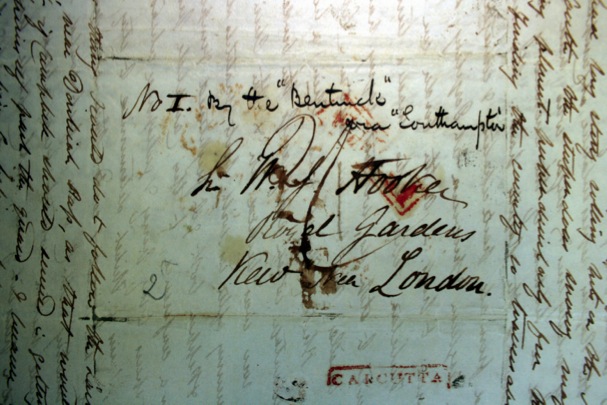
Letter from Joseph Hooker to Sir William Hooker from Calcutta (courtesy of Royal Botanic Gardens Kew UK)
I have great admiration for the staff at Kew and elsewhere who have transposed many of the Indian letters for the Joseph Hooker Correspondence project.
As Joseph aged his writing style became more free flowing but even harder to read. At times I look at a page and it seems to resemble Arabic with its swirls and curves and I find it hard to understand anything. So I write down what I can understand and leave gaps for the rest. I then go back after a while and sometimes the missing paragraph jumps out at me and I wonder why I couldn’t read it before. The more I read, the easier it is to understand but then I encounter botanical names of plants and they require some detective work. Some recent letters on Cupressi are a good example. At present they are only partly transposed and I would be happy to provide high resolution photos to anyone who could further assist with this job. The transposed letters will be provided to Harvard University. All letters are courtesy of the Asa Gray – University of Harvard Herbaria .
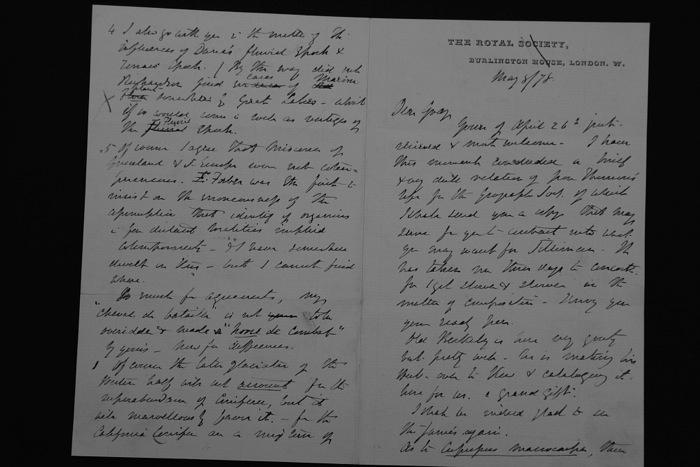
IMG 3926 Pages 1 and 4 Peter Donaldson
Royal Society Burlington House May 8/78
Dear Gray
Yours of April 26 just received and much welcome. I have this moment concluded a brief and very dull relation of … … life for the Geographical journal? Of which I shall send you a copy that may serve for you to contract into what you want for Stillman. It has taken me three days to construct for I get slower and slower in the matter of composition – I envy you your ready pen.
Max? Bertaly? Is here …. But pretty weak – he is making his herbarium over to Kew and cataloguing it here for us. A grand gift:
I …. Be indeed glad to see the James? Again.
As to the Cupressus macrocarpus, (Monterey Pine Editor) there
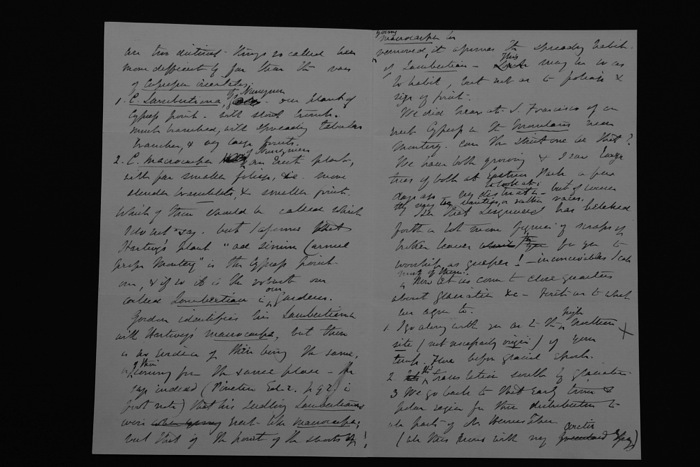
IMG 3927 pages 2 and 3 Peter Donaldson
…are two distinct ? things .. called here more difficult by than the varieties? of Cupressus
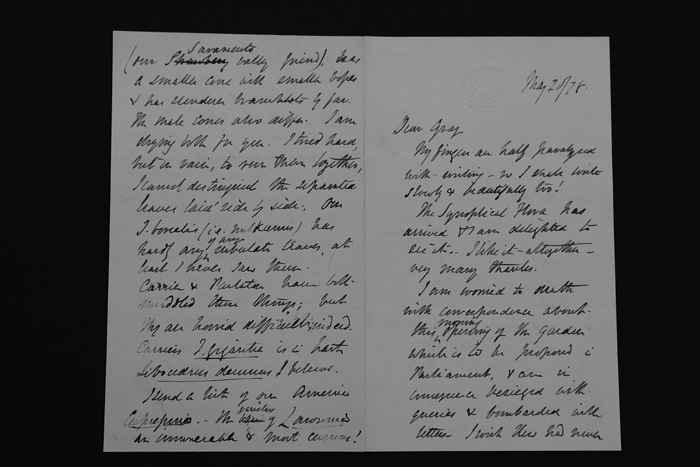
IMG 3930 pages 1 and 4 Peter Donaldson
May 25 /78
My fingers are half paralysed with writing – so I shall write slowly and beautifully too!
The …..Flora has arrived and I am delighted to see it- I like it altogether – very many thanks.
I am worried to death with correspondence about the morning opening of the Garden which is to be proposed to Parliament and am in correspondence besieged with queries and bombarded with letters. I wish Kew had never
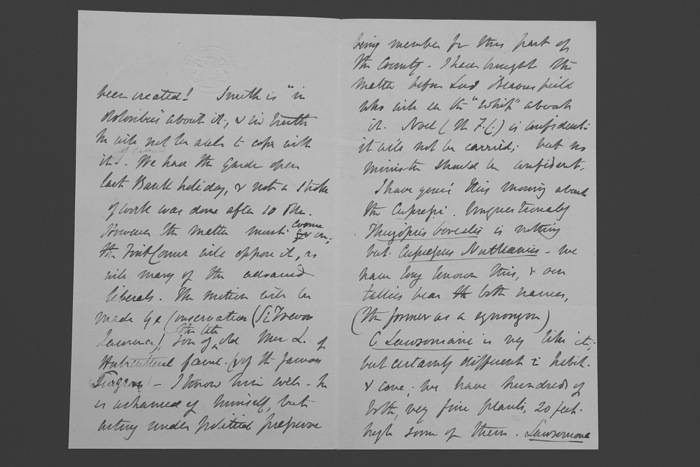
IMG 3931 pages 2 and 3 Peter Donaldson
been created!. Smith is in …. about it and in truth his wife not … able to cope with it… We had the Garden open last Bank Holiday, and not a stroke of work was done after 10 AM?
However the matter must come on, The First ?… will oppose it, as will many of the advanced liberals. The motion will be made by Sir?(….(Sir Trevor Lawrence) the son of the late old Mr L ….. I know him well. …is … .. himself, but is acting under political pressure, being member for this part of the County. I have brought the matter before Lord ….. who … whip… it. Noel (….) is confident it will not be carried, but no minister should be confident.
I have your’s this morning about the Cupressi. Unquestionably nthyopsris? bovesli is nothing but Cupressus Nuthanis? – we have long known this, and our tallies bear both names (the former as a synonym)
C Lawsoniani is very like it but certainly different in habit and cone; we have hundreds of both very fine plants; 20 feet high some of them. Lawsoniana
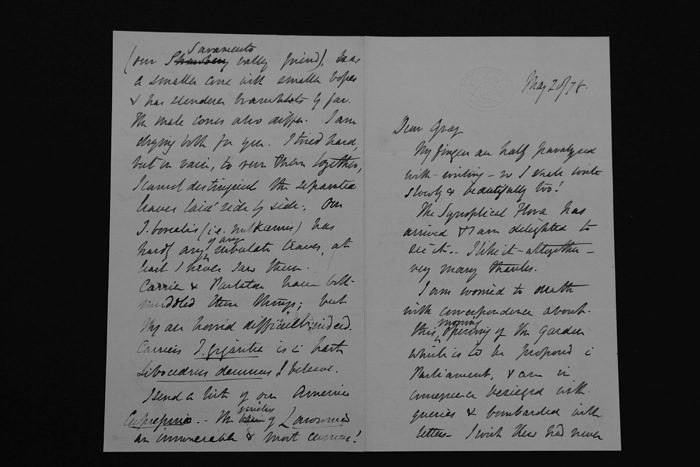
IMG 3930 pages 4 (left) and 1Peter Donaldson
(our Sacramento valley friend) has a smaller cone with smaller …. and has slenderer branchlets by far. The male cones also differ. I am drying both for you. I tried hard but in vain, to run? them together. I cannot distinguish the separate leaves side by side. Our J boxcais? (ie Nutkatensis (Nootkatensis-editor?) has hardly any of … subulate? Leaves, at least I never saw them.
Carrier? And paulatan? Have both muddled these things but they are horrid difficulties;; …. Carriers S gigantis is a …. Libocedrus dec…. I believe.
I send a list of our American Cupressi.. the …. of Lawsoniana? are innumerable and most curious?
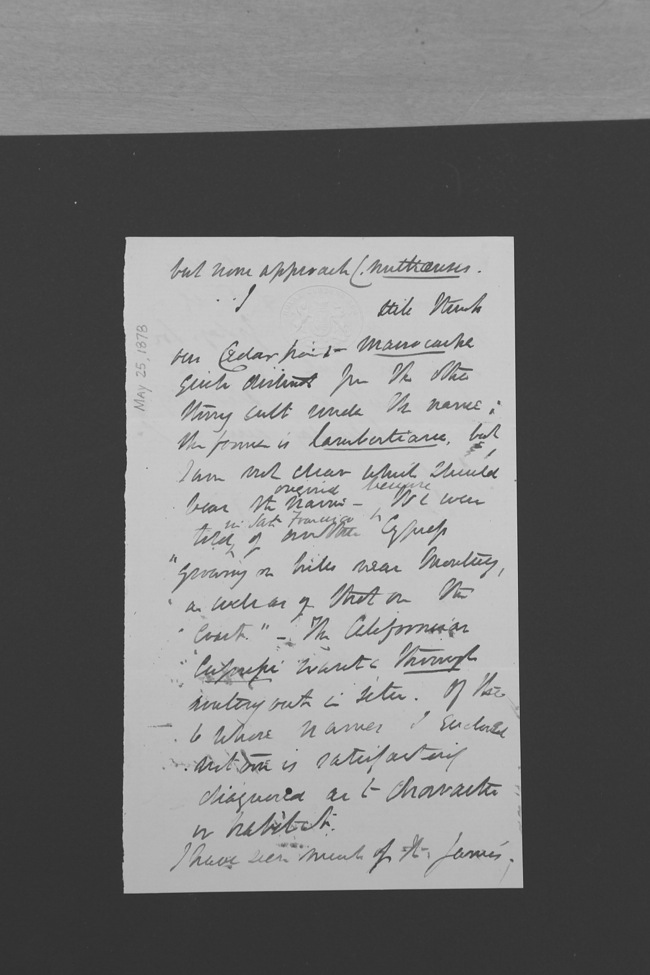
IMG 3932 Page 5 Peter Donaldson
May 25 78
But none approach C nuthiansis?. or nootkatensis possibly-Editor……
I have seen much of ….. James?
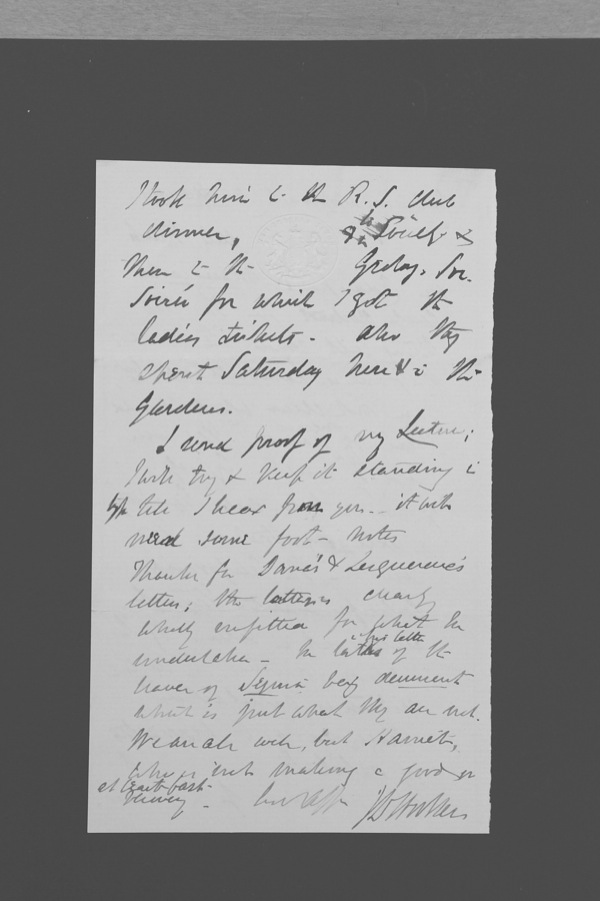
IMG 3933 page 6 Peter Donaldson
I took him to the Royal Society club dinner then to the Geographical? Society soiree for which I got the ladies tickets. Also we spent Saturday here in the Gardens.
I send proof of my lecture. I will try to keep it standing in type? Until I hear from you. It will need some foot notes.
Thanks for Danas’ and lequ…. letter; the latter clearly wholly unfitted for what he’s undertaken - … In … his letter of the… of ….. …. ….. which is just what they are not. We are all well but Harriet who is not making a good …. …. recovery? JDH
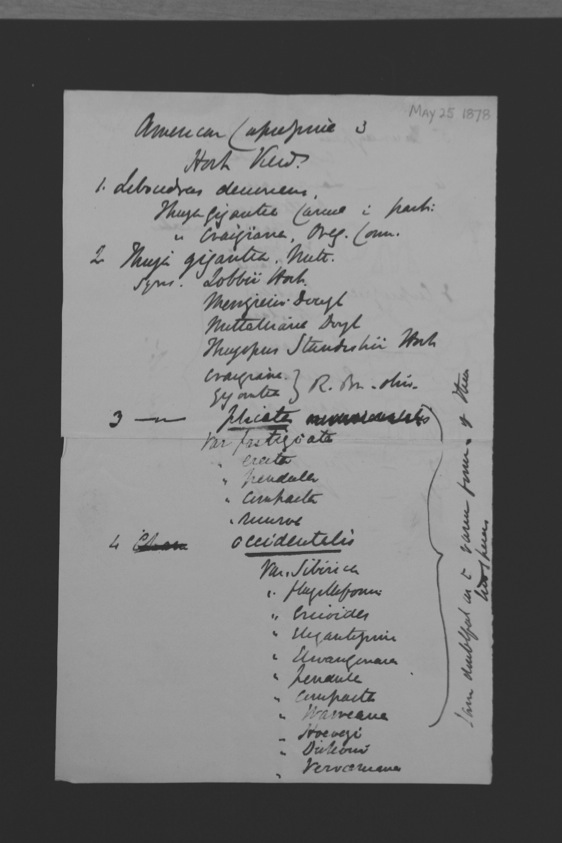
IMG3934 page 7 Peter Donaldson
May 25 78
American Cupressus at ….. Kew
List 1-4
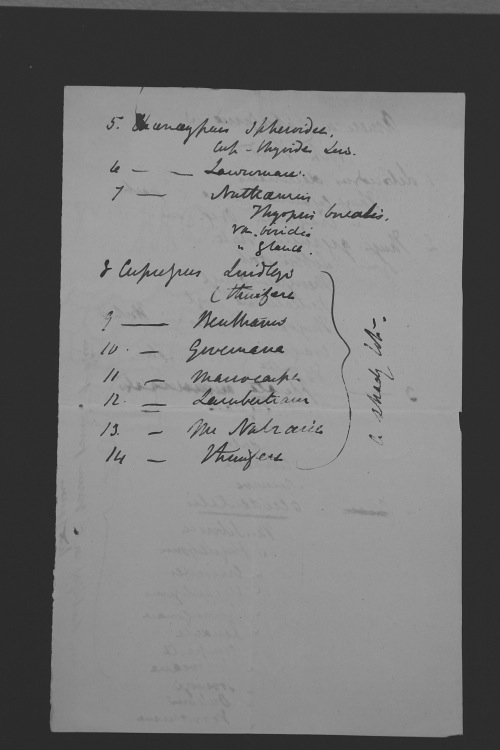
IMG3935 Page 8 Peter Donaldson
List of Cupressus continued
Species 5- 14
Any help deciphering these letters and in particular the botanical names would be most appreciated.
If we have success with this I will post the deciphered letter and more letters .
This has been of much interest to Bill Weber a veteran botanist in Colorado for many years. His paper is entitled ‘The Middle Asian element in the Southern Rocky Mountain Flora of the western United States : a critical biogeographical review’, William A Weber, Herbarium COLO, University of Colorado, Campus Box 265 Boulder CO 80309 USA, Copyright 2003 Blackwell Publishing Ltd. Bill had only seen passing reference to it and I was hoping to find out more as I was about to retrace Joseph’s and Asa’s travels through the American west. The idea seemed to get lost during the writing of an important paper by Joseph and Asa called ‘The Vegetation of the Rocky Mountain Region and a Comparison with that of other Parts of the World’ available as a reprint from www.rarebooksclub.com.
When I first contacted the Asa Gray Herbarium they thought they had only a few letters from Joseph during the years of interest but managed to find a number more for my visit. I photographed them and am now attempting to decipher them. As anyone who has tried to read Joseph’s letters will agree this is no mean feat. His early letters from India to his father Sir William are very difficult to read as he used slanted script and small writing and wrote them on thin paper. The result is that the writing on the back has bled through resulting in a page having two scripts almost at right angles to each other. An example of this is shown below. Interestingly the letters he wrote from India to his fiancée are much easier to read and the language much more free flowing.

Letter from Joseph Hooker to Sir William Hooker from Calcutta (courtesy of Royal Botanic Gardens Kew UK)
I have great admiration for the staff at Kew and elsewhere who have transposed many of the Indian letters for the Joseph Hooker Correspondence project.
As Joseph aged his writing style became more free flowing but even harder to read. At times I look at a page and it seems to resemble Arabic with its swirls and curves and I find it hard to understand anything. So I write down what I can understand and leave gaps for the rest. I then go back after a while and sometimes the missing paragraph jumps out at me and I wonder why I couldn’t read it before. The more I read, the easier it is to understand but then I encounter botanical names of plants and they require some detective work. Some recent letters on Cupressi are a good example. At present they are only partly transposed and I would be happy to provide high resolution photos to anyone who could further assist with this job. The transposed letters will be provided to Harvard University. All letters are courtesy of the Asa Gray – University of Harvard Herbaria .

IMG 3926 Pages 1 and 4 Peter Donaldson
Royal Society Burlington House May 8/78
Dear Gray
Yours of April 26 just received and much welcome. I have this moment concluded a brief and very dull relation of … … life for the Geographical journal? Of which I shall send you a copy that may serve for you to contract into what you want for Stillman. It has taken me three days to construct for I get slower and slower in the matter of composition – I envy you your ready pen.
Max? Bertaly? Is here …. But pretty weak – he is making his herbarium over to Kew and cataloguing it here for us. A grand gift:
I …. Be indeed glad to see the James? Again.
As to the Cupressus macrocarpus, (Monterey Pine Editor) there

IMG 3927 pages 2 and 3 Peter Donaldson
…are two distinct ? things .. called here more difficult by than the varieties? of Cupressus

IMG 3930 pages 1 and 4 Peter Donaldson
May 25 /78
My fingers are half paralysed with writing – so I shall write slowly and beautifully too!
The …..Flora has arrived and I am delighted to see it- I like it altogether – very many thanks.
I am worried to death with correspondence about the morning opening of the Garden which is to be proposed to Parliament and am in correspondence besieged with queries and bombarded with letters. I wish Kew had never

IMG 3931 pages 2 and 3 Peter Donaldson
been created!. Smith is in …. about it and in truth his wife not … able to cope with it… We had the Garden open last Bank Holiday, and not a stroke of work was done after 10 AM?
However the matter must come on, The First ?… will oppose it, as will many of the advanced liberals. The motion will be made by Sir?(….(Sir Trevor Lawrence) the son of the late old Mr L ….. I know him well. …is … .. himself, but is acting under political pressure, being member for this part of the County. I have brought the matter before Lord ….. who … whip… it. Noel (….) is confident it will not be carried, but no minister should be confident.
I have your’s this morning about the Cupressi. Unquestionably nthyopsris? bovesli is nothing but Cupressus Nuthanis? – we have long known this, and our tallies bear both names (the former as a synonym)
C Lawsoniani is very like it but certainly different in habit and cone; we have hundreds of both very fine plants; 20 feet high some of them. Lawsoniana

IMG 3930 pages 4 (left) and 1Peter Donaldson
(our Sacramento valley friend) has a smaller cone with smaller …. and has slenderer branchlets by far. The male cones also differ. I am drying both for you. I tried hard but in vain, to run? them together. I cannot distinguish the separate leaves side by side. Our J boxcais? (ie Nutkatensis (Nootkatensis-editor?) has hardly any of … subulate? Leaves, at least I never saw them.
Carrier? And paulatan? Have both muddled these things but they are horrid difficulties;; …. Carriers S gigantis is a …. Libocedrus dec…. I believe.
I send a list of our American Cupressi.. the …. of Lawsoniana? are innumerable and most curious?

IMG 3932 Page 5 Peter Donaldson
May 25 78
But none approach C nuthiansis?. or nootkatensis possibly-Editor……
I have seen much of ….. James?

IMG 3933 page 6 Peter Donaldson
I took him to the Royal Society club dinner then to the Geographical? Society soiree for which I got the ladies tickets. Also we spent Saturday here in the Gardens.
I send proof of my lecture. I will try to keep it standing in type? Until I hear from you. It will need some foot notes.
Thanks for Danas’ and lequ…. letter; the latter clearly wholly unfitted for what he’s undertaken - … In … his letter of the… of ….. …. ….. which is just what they are not. We are all well but Harriet who is not making a good …. …. recovery? JDH

IMG3934 page 7 Peter Donaldson
May 25 78
American Cupressus at ….. Kew
List 1-4

IMG3935 Page 8 Peter Donaldson
List of Cupressus continued
Species 5- 14
Any help deciphering these letters and in particular the botanical names would be most appreciated.
If we have success with this I will post the deciphered letter and more letters .
Latest video gear for expedition filmmakers
03/03/14 17:06
Since my first Himalayan Hooker expedition in 2008 video gear has advanced quite a lot. Whilst the Sony EX1 camera is still an excellent camera, the advent of digital still cameras, such as the Canon 5D which can also shoot full HD video, has been a game changer. The other major advance is that very small full HD cameras such as the GoPro have enabled the getting of shots which were previously almost impossible.
So originally we used a Sony Ex1 with inbuilt sound recording, a shotgun Rode NTG2 mike in a wind blimp and occasionally a Sennheiser radio mike. Using the Canon 5D (mine is a Mk 2 with Magic Lantern software) has some advantages and disadvantages.
First of the advantages for me are that you can shoot guerrilla style. By this I mean that in locations where videoing is difficult for political or other reasons it looks like only a DSLR still camera is being used. This was the case in Sikkim where a large Army presence means that videoing was not easy. Far better not to video anything of any sensitivity and so not draw attention to oneself with big equipment. It is better using a tiny GoPro.
Secondly the very large sensor in the 5D means that a very shallow depth of field is possible. By this I mean that one can spotlight subjects such as a flower and have the background out of focus. Low light shooting is also better. Furthermore the quality of the footage is superlative. Interchangeable lenses mean that macro, extreme wide and telephotos results are also much better. Stills can be shot with the same equipment.
Disadvantages are fairly numerous and include the possibility of dust entering the camera when the lenses are changed, difficulty of zooming as there is no power zoom, difficulties in focusing due to no easy-to-see screen, difficulties in videoing small plants as the screen is not tilt-able. Poor quality internal sound amplifiers , etc. Most of these and other issues can be solved by adding additional equipment such as an external monitor and recording sound externally with a recorder such as the Zoom H4n, but before long you end up with a larger setup than before.
Despite these drawbacks the higher quality means that the Canon or other DSLR route is now usually preferred, even more so now that the Canon 5D Mk 3 produces even better results than the Mk 2, particularly in low light and where striped shadows are present (less moire). There has been an explosion of aftermarket equipment for these cameras and I list a few items which I consider necessities for shooting a botanical expedition film.
The first is a variable neutral density filter. This allows you to continue shooting with a shallow depth of field at around one-fiftieth of a second (necessary for good video footage) even if the light is strong. This is an absolute must have.
The second is a focusing aid. There are many rail based systems but for me they are too cumbersome. I use a simple cheap system made by FocusMaker see www.focusmaker.com. This is a great little tool for videoing plants as it allows a rack focus to be planned and easily executed. For example, focusing on one part of a plant with a shallow focus and then changing the focus during a pan , etc.
Thirdly a very small jib such as that made by Glideshot, see www.glideshot.com. This allows the camera to move not just by panning the tripod but also laterally and vertically. The result is a 3 dimensionality in the footage. I have modified my unit by cutting it in half and then joining it together with braces. This means that it now fits inside a regular suitcase. I have also added an extension bar with a sliding weight and use a bag as a weight which I fill with sand or rocks. In this way I carry the minimum weight. An external monitor is useful but not essential. However a good carbon fibre video tripod is a must. Mine is a Miller with a DS10 head when weight matters and a Compass 12 head when it doesn’t and I am after a very slow pan with no stutter. For altitude or when I have to carry everything myself I get away with an extremely light carbon fibre tripod with a tiny Manfrotto 128RC head but anchor it down well and don’t try to pan unless really necessary. I also have a 1 metre long set of rails and an electric programmable speed carriage which I use for time lapse sequences or vertical pans along a plant. Recently I videoed a beautiful waratah (telopea speciosissima) using the rails vertically so that the shot started on the stem and then very slowly climbed up the plant to reveal the spectacular flower.
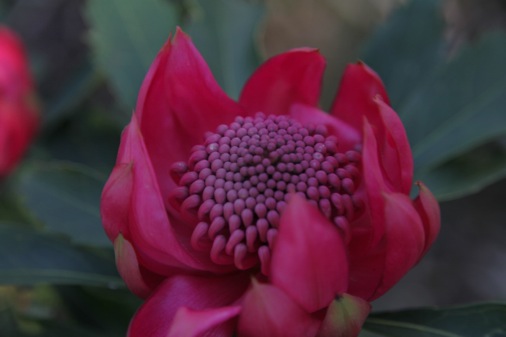
Telopea speciosissima
Now to the GoPro:
How I wish I had had one of these in the Himalayas as I could have worn it on my hat or chest whenever the going was dangerous. I now have three of them and two are WiFi controlled from a wrist controller or my iPhone. They are cheap and I lend them to friends who are going to unusual places such as the Arctic or the Antarctic.
I recently used a GoPro3 in the USA while retracing the travels of Joseph Hooker and Asa Gray there in 1877. The first shot was at Penn Central station in New York. I used a GoPro on a short walking stick and recorded myself walking through the station talking to the camera. As it has a very wide angle lens everything is in focus and most people did not realise I was filming. I recorded sound on my iPhone using a Rode SmartLav microphone. See www.smartlav.com. This would have to be the simplest way to get good quality footage and sound on the move and without any crew.
In the sequoia forests of California the problem was how to show the size of the trees without very elaborate equipment. My solution was to install a GoPro on the roof of my car and then drive very slowly past some of the giants. Again the movement introduces a 3 dimensionality which helps convey size. This can then be intercut with slow pans from the Canon 5D to improve the quality of the sequence. In Redwood National Park it was raining so I used a GoPro on a walking stick in the rain (it comes in an underwater housing) again with the SmartLav and iPhone. I then had total freedom to walk amongst the trees and talk to the camera in very poor conditions.
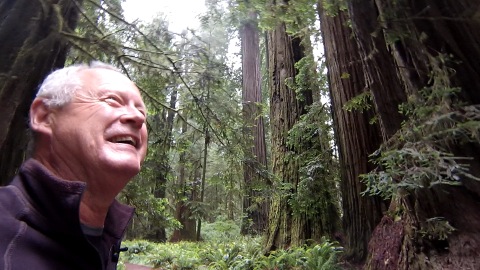
GoPro screen shot in Redwood National Park, California
Next week: Back to Joseph Hooker
So originally we used a Sony Ex1 with inbuilt sound recording, a shotgun Rode NTG2 mike in a wind blimp and occasionally a Sennheiser radio mike. Using the Canon 5D (mine is a Mk 2 with Magic Lantern software) has some advantages and disadvantages.
First of the advantages for me are that you can shoot guerrilla style. By this I mean that in locations where videoing is difficult for political or other reasons it looks like only a DSLR still camera is being used. This was the case in Sikkim where a large Army presence means that videoing was not easy. Far better not to video anything of any sensitivity and so not draw attention to oneself with big equipment. It is better using a tiny GoPro.
Secondly the very large sensor in the 5D means that a very shallow depth of field is possible. By this I mean that one can spotlight subjects such as a flower and have the background out of focus. Low light shooting is also better. Furthermore the quality of the footage is superlative. Interchangeable lenses mean that macro, extreme wide and telephotos results are also much better. Stills can be shot with the same equipment.
Disadvantages are fairly numerous and include the possibility of dust entering the camera when the lenses are changed, difficulty of zooming as there is no power zoom, difficulties in focusing due to no easy-to-see screen, difficulties in videoing small plants as the screen is not tilt-able. Poor quality internal sound amplifiers , etc. Most of these and other issues can be solved by adding additional equipment such as an external monitor and recording sound externally with a recorder such as the Zoom H4n, but before long you end up with a larger setup than before.
Despite these drawbacks the higher quality means that the Canon or other DSLR route is now usually preferred, even more so now that the Canon 5D Mk 3 produces even better results than the Mk 2, particularly in low light and where striped shadows are present (less moire). There has been an explosion of aftermarket equipment for these cameras and I list a few items which I consider necessities for shooting a botanical expedition film.
The first is a variable neutral density filter. This allows you to continue shooting with a shallow depth of field at around one-fiftieth of a second (necessary for good video footage) even if the light is strong. This is an absolute must have.
The second is a focusing aid. There are many rail based systems but for me they are too cumbersome. I use a simple cheap system made by FocusMaker see www.focusmaker.com. This is a great little tool for videoing plants as it allows a rack focus to be planned and easily executed. For example, focusing on one part of a plant with a shallow focus and then changing the focus during a pan , etc.
Thirdly a very small jib such as that made by Glideshot, see www.glideshot.com. This allows the camera to move not just by panning the tripod but also laterally and vertically. The result is a 3 dimensionality in the footage. I have modified my unit by cutting it in half and then joining it together with braces. This means that it now fits inside a regular suitcase. I have also added an extension bar with a sliding weight and use a bag as a weight which I fill with sand or rocks. In this way I carry the minimum weight. An external monitor is useful but not essential. However a good carbon fibre video tripod is a must. Mine is a Miller with a DS10 head when weight matters and a Compass 12 head when it doesn’t and I am after a very slow pan with no stutter. For altitude or when I have to carry everything myself I get away with an extremely light carbon fibre tripod with a tiny Manfrotto 128RC head but anchor it down well and don’t try to pan unless really necessary. I also have a 1 metre long set of rails and an electric programmable speed carriage which I use for time lapse sequences or vertical pans along a plant. Recently I videoed a beautiful waratah (telopea speciosissima) using the rails vertically so that the shot started on the stem and then very slowly climbed up the plant to reveal the spectacular flower.

Telopea speciosissima
Now to the GoPro:
How I wish I had had one of these in the Himalayas as I could have worn it on my hat or chest whenever the going was dangerous. I now have three of them and two are WiFi controlled from a wrist controller or my iPhone. They are cheap and I lend them to friends who are going to unusual places such as the Arctic or the Antarctic.
I recently used a GoPro3 in the USA while retracing the travels of Joseph Hooker and Asa Gray there in 1877. The first shot was at Penn Central station in New York. I used a GoPro on a short walking stick and recorded myself walking through the station talking to the camera. As it has a very wide angle lens everything is in focus and most people did not realise I was filming. I recorded sound on my iPhone using a Rode SmartLav microphone. See www.smartlav.com. This would have to be the simplest way to get good quality footage and sound on the move and without any crew.
In the sequoia forests of California the problem was how to show the size of the trees without very elaborate equipment. My solution was to install a GoPro on the roof of my car and then drive very slowly past some of the giants. Again the movement introduces a 3 dimensionality which helps convey size. This can then be intercut with slow pans from the Canon 5D to improve the quality of the sequence. In Redwood National Park it was raining so I used a GoPro on a walking stick in the rain (it comes in an underwater housing) again with the SmartLav and iPhone. I then had total freedom to walk amongst the trees and talk to the camera in very poor conditions.

GoPro screen shot in Redwood National Park, California
Next week: Back to Joseph Hooker


